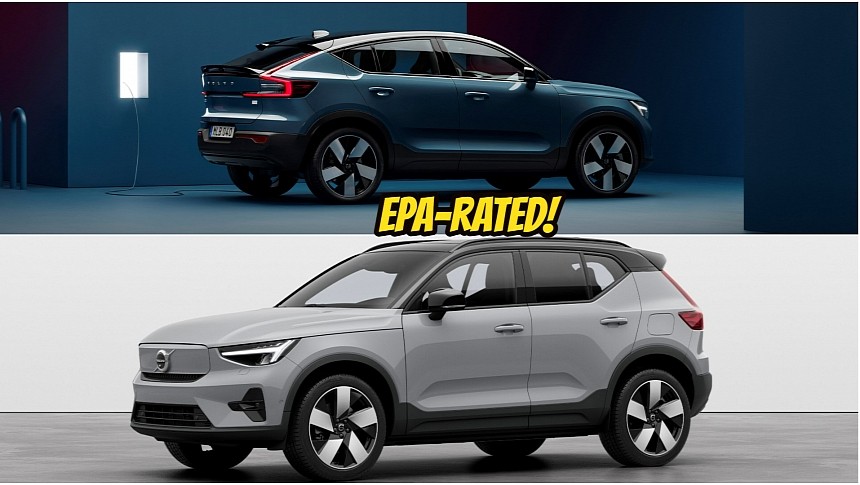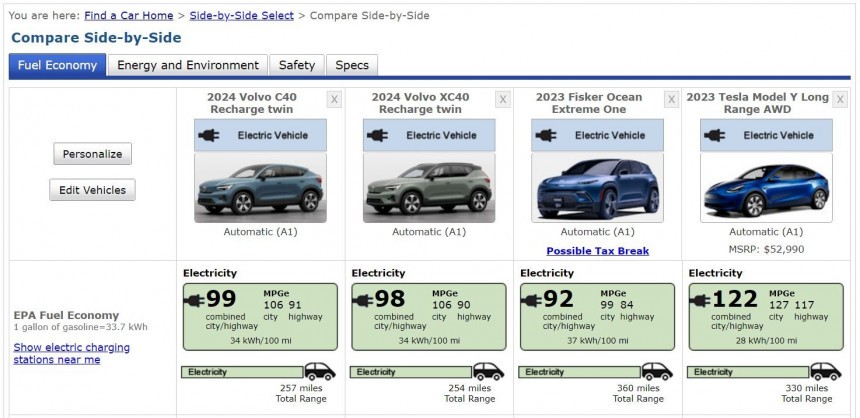The Environmental Protection Agency (EPA) updated the range figures for the 2024 Volvo C40 Recharge and XC40 Recharge. The compact crossover SUVs can now go farther on a single charge and display better efficiency than the outgoing models. Here's the gist of it.
We first learned about the tweaked vehicles in April, when the Europeans verified the updated EVs. The American testing procedure, however, was not as indulgent as the WLTP.
The twin-motor 2024 Volvo C40 Recharge can now travel 257 miles on a full battery. The all-wheel-drive EV gained 31 miles of range over the 2023 model year unit. It's also more efficient! Now, it needs just 34 kWh / 100 miles or, depending on how you like to see the measurements, 2.94 miles per kWh.
The less stylish but more practical twin-motor 2024 Volvo XC40 Recharge boasts a range of 254 miles. That translates into a similar 31-mile travel improvement from 100% to 0% state of charge (SoC). The family-oriented vehicle eased its electron consumption. The updated unit asks the battery for 34 kWh per 100 miles, which results in the same 2.94 miles per kWh as its more fabulous brother.
These figures are unsurprising, considering that Volvo builds the XC40 Recharge and the C40 Recharge on the same Compact Modular Architecture (CMA) platform. The units have identical wheelbases and body widths.
The only difference is the headspace for the rear passengers. The XC40 Recharge is better in this regard because it doesn't boast the same sloped rear roofline. Moreover, it has a better starting price – $53,550 sans freight. The coupe-ish C40 Recharge asks for $1,750 more.
But the EPA went even further and tested the rear-wheel-drive versions of the two EVs, too! The automaker might soon add them to its web tool even though they're not available to be configured online when writing.
It might want to move fast because the single-motor 2024 Volvo C40 Recharge can go 297 miles on a single charge. Its practical but slightly less aerodynamic sibling gets 293 miles of range on a full battery. Both, however, have a very similar efficiency figure – 31 kWh per 100 miles (3.22 miles per kWh) for the C40, while the XC40 needs 1 kWh more every 100 miles (3.12 miles per kWh).
Remember that real-world figures may vary depending on factors like the weather, battery health, or driving style.
But even with these great upgrades, the all-wheel-drive C40 Recharge and XC40 Recharge are no match for rivals like the Fisker Ocean Extreme and Tesla Model Y Long Range, which can go 360 miles and 330 miles on a full battery.
The two Volvos are more closely matched with the all-wheel-drive Hyundai Ioniq 5 and Kia EV6. Check out the photo gallery for more numbers.
The EPA's testing procedure for all-electric vehicles happens exclusively in a lab, on a dynamometer. It charges the car to full, leaves it overnight, and puts it to work the next day until the battery dies. That happens at least two times, at different speeds – once for the city cycle, once for the highway cycle. The EPA says it repeats these procedures "multiple times."
Afterward, the energy storage unit is charged to full at a normal AC source, and the energy consumption is determined by dividing the kilowatt-hours of energy to recharge the battery by the miles traveled by the vehicle.
The agency gives city range figures more weight (55%) when establishing the combined city and highway range (45%) figures.
Automakers can also establish their own range values by doing four city cycles, two highway cycles, and two constant speed cycles. Fisker proved that the data can match with what the EPA is doing when the procedures are respected.
The twin-motor 2024 Volvo C40 Recharge can now travel 257 miles on a full battery. The all-wheel-drive EV gained 31 miles of range over the 2023 model year unit. It's also more efficient! Now, it needs just 34 kWh / 100 miles or, depending on how you like to see the measurements, 2.94 miles per kWh.
The less stylish but more practical twin-motor 2024 Volvo XC40 Recharge boasts a range of 254 miles. That translates into a similar 31-mile travel improvement from 100% to 0% state of charge (SoC). The family-oriented vehicle eased its electron consumption. The updated unit asks the battery for 34 kWh per 100 miles, which results in the same 2.94 miles per kWh as its more fabulous brother.
These figures are unsurprising, considering that Volvo builds the XC40 Recharge and the C40 Recharge on the same Compact Modular Architecture (CMA) platform. The units have identical wheelbases and body widths.
The only difference is the headspace for the rear passengers. The XC40 Recharge is better in this regard because it doesn't boast the same sloped rear roofline. Moreover, it has a better starting price – $53,550 sans freight. The coupe-ish C40 Recharge asks for $1,750 more.
But the EPA went even further and tested the rear-wheel-drive versions of the two EVs, too! The automaker might soon add them to its web tool even though they're not available to be configured online when writing.
It might want to move fast because the single-motor 2024 Volvo C40 Recharge can go 297 miles on a single charge. Its practical but slightly less aerodynamic sibling gets 293 miles of range on a full battery. Both, however, have a very similar efficiency figure – 31 kWh per 100 miles (3.22 miles per kWh) for the C40, while the XC40 needs 1 kWh more every 100 miles (3.12 miles per kWh).
Remember that real-world figures may vary depending on factors like the weather, battery health, or driving style.
But even with these great upgrades, the all-wheel-drive C40 Recharge and XC40 Recharge are no match for rivals like the Fisker Ocean Extreme and Tesla Model Y Long Range, which can go 360 miles and 330 miles on a full battery.
The EPA's testing procedure for all-electric vehicles happens exclusively in a lab, on a dynamometer. It charges the car to full, leaves it overnight, and puts it to work the next day until the battery dies. That happens at least two times, at different speeds – once for the city cycle, once for the highway cycle. The EPA says it repeats these procedures "multiple times."
Afterward, the energy storage unit is charged to full at a normal AC source, and the energy consumption is determined by dividing the kilowatt-hours of energy to recharge the battery by the miles traveled by the vehicle.
The agency gives city range figures more weight (55%) when establishing the combined city and highway range (45%) figures.
Automakers can also establish their own range values by doing four city cycles, two highway cycles, and two constant speed cycles. Fisker proved that the data can match with what the EPA is doing when the procedures are respected.









